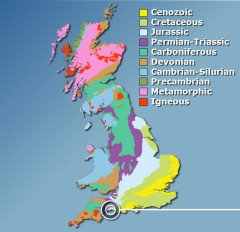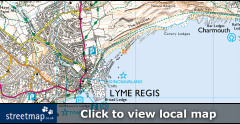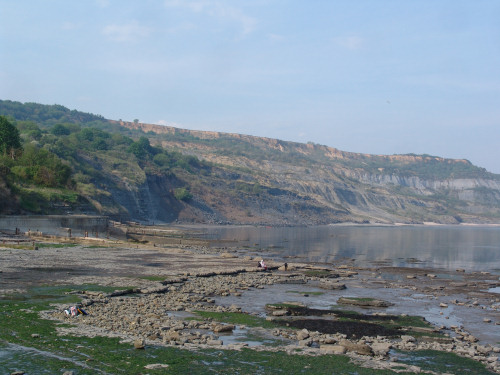
Established 2002
Lucinda Shepherd, friend Robert Randell and various experts for their support.
Lyme Regis (Dorset)

Click above to view page as a PDF.
Click here to download PDF software.
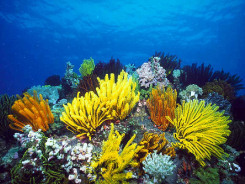
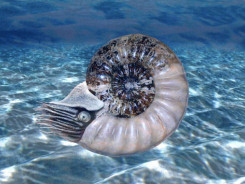
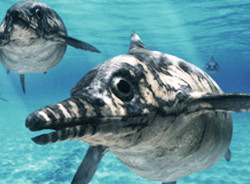
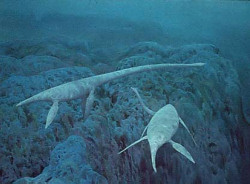
Introduction
Lyme Regis is located on the Dorset coast, and represents a significant part of the Jurassic Coast - World Heritage Site. The rocks date predominantly from the Early Jurassic epoch, approximately 199-189 million years ago, during which time a warm sea spread across much of the UK. The famous coastline has yielded a range of spectacular fossils, including: giant marine reptiles, intricate crinoids, ammonites and even dinosaur remains. The volume and quality of finds over the past two centuries in particular, have made Lyme Regis one of the most famous fossil locations in the world.
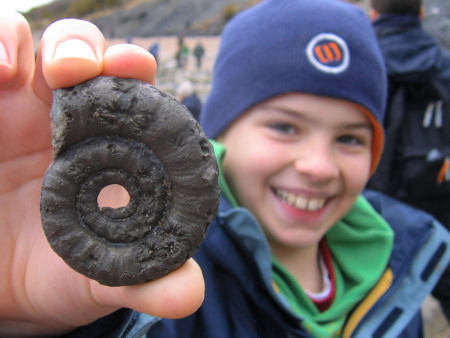
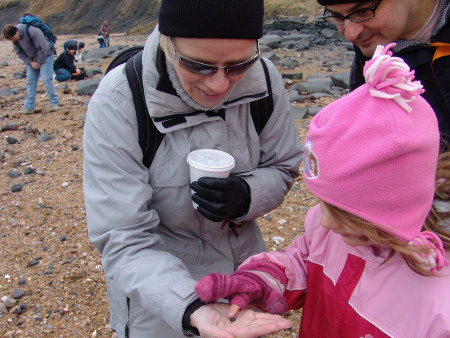
Left: Discovering
Fossils event participants admire a small ammonite. Right:
A pyritised ammonite - Eoderoceras armatum, from the
foreshore.
Parking is available in several car parks within Lyme Regis and also at the neighbouring village of Charmouth (for visitors planning to walk between the two locations); a local taxi and bus service are available, but fast walkers may prefer to travel the return journey on foot.
Lyme Regis was thrust into the limelight in 1811, when a number of significant marine reptile remains were discovered by local fossil collectors Mary Anning and her brother Joseph Anning. Among their finds include the first recognised complete ichthyosaur skeleton, the skull of which was found by Joseph, and the rest of the skeleton by Mary soon after. A number of Mary's discoveries, can be viewed in the Natural History Museum of London.
Today, fossils can still be found and collected in large numbers on the beach and from the leading edge of the slumping clays along the coastline. The best time to fossil hunt is on a falling tide, as fossils are re-deposited on the foreshore by the retreating sea. The rapidly eroding cliffs and foreshore ensure a fresh supply of fossils every day, although this also presents a danger of rock falls, so it's advisable to keep a safe distance from the cliff base.
Lyme Regis is suitable for individuals and families of all ages and levels of experience. A hammer, chisel and eye protection are recommended for splitting prospective rocks, although many fossils can also be found loose among the pebbles and rock pools.
The geology of Lyme Regis (east)
The cliffs and foreshore between Lyme Regis and Charmouth represent three stages within the Early Jurassic (or Lias) period termed the Hettangian, Sinemurian and Pliensbachian dating from approximately 199-189 million years ago. During this time a shallow epicontinental sea (less than 100m deep), was present across much of Europe, including most of England, Wales and Ireland, and laid down alternating layers of clay and limestone. At that time, Lyme Regis (as it's now known), lay closer to the equator, roughly at the latitude North Africa is today. Overlying the Jurassic sediments are younger Cretaceous deposits, comprising the Gault and the golden coloured Upper Greensand (green when freshly split) - deposited around 106-102 million years ago (fig.1 below).

Figure 1: A summary
of the positions of the Cretaceous and Jurassic horizons on Black
Ven, east of Lyme Regis.

Figure 2: Diagram indicating the positions of the key geological
horizons of Black Ven, east of Lyme Regis. For a table of geologic
periods
click here.
Fossils can be found throughout the Jurassic and Cretaceous exposures at Lyme Regis, however it's the Jurassic rocks in particular that attract fossil hunters to Lyme Regis.
Life was abundant during the Jurassic period, giant marine reptiles inhabited the seas and pterosaurs flew across the skies. This was also the time of the dinosaurs, however the presence of sea over the area and distance from any significant landmass, means their fossils are rarely found at Lyme Regis. In 1858 and on few occasions since, the remains of a dinosaur named Scelidosaurus have been found in the Black Ven Marl Member described below. Scelidosaurus was an armour-plated quadruped, with rear legs much longer than the front. Examination of the bones and teeth reveals Scelidosaurus was a herbivorous (plant eating) dinosaur, which grew up to 4m in length.
The occurrence of dinosaur remains within these marine sediments remains unproven, however the most likely case was that the bloated carcasses floated out to sea, perhaps caught out by monsoonal flash floods. The presence of dinosaur remains is a fascinating addition to the local palaeontology of the area.
There are two important Jurassic formations present in the cliffs beneath Black Ven -the Blue Lias Formation and Charmouth Mudstone Formation, the latter of which is subdivided into a number of sections: Shales-with-Beef, Black Ven Marls, Belemnite Marls and an isolated exposure of the Green Ammonite Mudstone Member (highlighted in fig.2 above). Each formation/member is described briefly below.
Blue Lias Formation - The oldest rocks at Lyme Regis belong to the Blue Lias Formation and date from around 199 million years ago. These hard, pale layers of limestone and darker organic-rich shales, occupy much of the foreshore around Lyme Regis, appearing as a series of ledges on the foreshore at low-tide (fig.1 above) and also in the cliffs immediately east of the town (fig.3 and 4 below); these particular cliffs, known as Church Cliffs, are the source of many fine examples of calcified ammonites. The total thickness of the Blue Lias Formation is 26 metres and dips gently towards the east, bringing successively younger/higher beds to beach level.
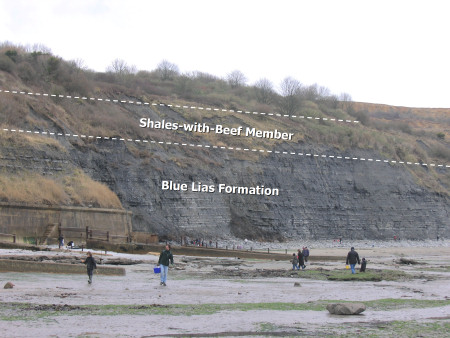
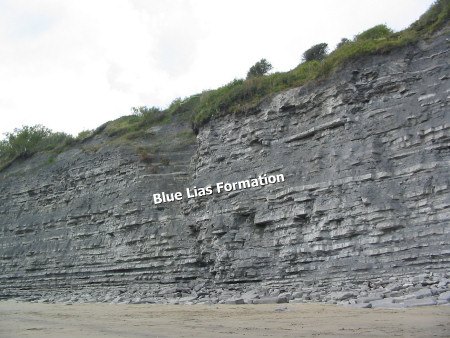
Figure 3: The Blue
Lias Formation represents the earliest rocks east of Lyme Regis and
can be clearly examined at Church Cliffs. Figure 4:
Church Cliffs.
The name Blue Lias originates from two sources, firstly to describe the blue tint caused by the high iron content within the rock, and secondly by a historic local pronunciation of the word 'layers' by local quarrymen.
Shales-with-Beef Member - Moving upwards the next formation encountered is the Charmouth Mudstone Formation, which is subdivided into a number of members, the lowest of which is the Shales-with-Beef Member and measures 30m from its base. The transition between the underlying Blue Lias Formation can be seen towards the top of Church Cliffs, beneath Black Ven (fig.3 above).
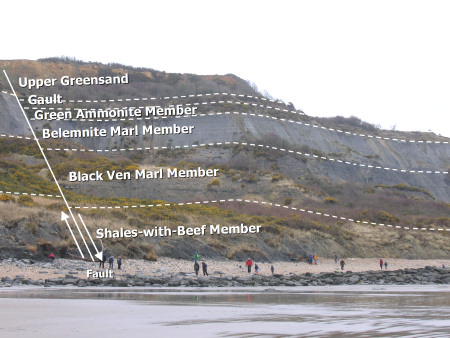
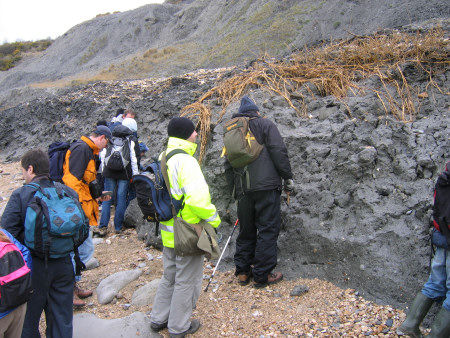
Figure 5: Half way
between Lyme Regis and Charmouth the Shales with Beef Member reaches
the foreshore. Right: Visitors examine the
Shales-with-Beef.
The Shales-with-Beef Member is dominated by dark mudstones, many of them organic-rich and finely laminated. Within the member are a series of thin (under 10cm), fibrous calcite beds, which give the appearance of sliced beef steak! Unfortunately, fossils within the member tend to be crushed and are best suited to scientific study.
Black Ven Marl Member - This member lies above the Shales-with-Beef Member, and comprises 27m of mostly dark-grey mudstones, with subordinate beds of nodular and tabular limestone. The Black Ben Marls only reach the foreshore at Charmouth, however the slumping cliffs often deposit large volumes of the member along the entire coastal stretch from Lyme Regis.
The transition from the underlying Shales-with-Beef Member is clearly marked by a distinctive limestone bed, known as the Birchi Tabular that appears in the cliff beneath Black Ven, towards Charmouth (fig.6 and 7 below).
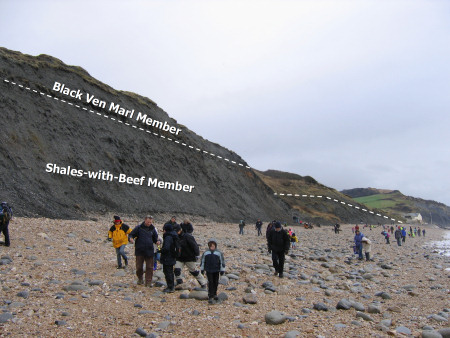
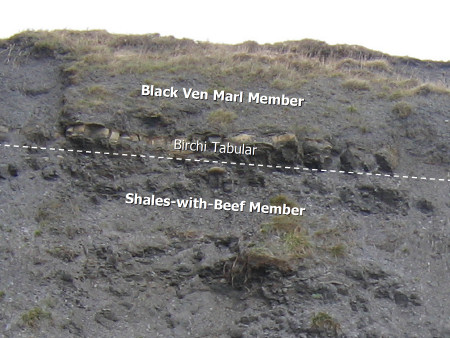
Figure 6: The
Shales-with-Beef Member is best examined towards Charmouth.
Figure 7: Birchi Tabular represents the transition between
the two members.
The Black Ven Marls have yielded some of the best fossils discovered at Lyme Regis, including the famous Scelidosaurus dinosaur remains (mentioned earlier) and a wide variety of exceptionally well preserved ammonites and giant ichthyosaur skeletons.
Perhaps the most commonly collected fossils within the Black Ven Marls are pyritised ammonites, however their preservation occurs at its best within the upper 17m of the formation; it's recently been proposed to separate and rename these beds to the 'Stonebarrow Pyritic Member'. These dark-coloured, pyrite rich sediments and are dominated by ammonites, including: Crucilobiceras, Eoderoceras, Echioceras and the distinctive, smooth surfaced, Oxynoticeras. The member lacks the large limestone nodules of the Black Ven Marls, with the exception of an isolated bed (0.3m thick) towards the top called the Watch Ammonite Stone.
Although present on Black Ven, the 'Stonebarrow Pyritic Member' and subsequent overlying members listed below, are best observed between Charmouth and Seatown.
Belemnite Marl Member: These deposits are seen towards the top of the cliffs, but are best examined beneath Golden Cap (Charmouth), where they appear on the sea-weathered foreshore. Despite the name given to the Belemnite Marl Member, ammonites are also abundant throughout the sediments.
The Belemnite Marls are easily identified on Black Ven, by their alternating pale and darker horizontal bands (fig.5 above). The different shades of grey are the result of the differing organic carbon content (higher in the darker bands). The Belemnite Marls extend 23m upwards, to the overlying Green Ammonite Mudstone Member.
Green Ammonite Mudstone Member: This member rests above the Belemnite Marls, but is isolated on Black Ven to a small exposure either side of the fault (Fig. 2 above). Ammonites are abundant and include species of Aegoceras, Oistoceras, Liparoceras, Tragophylloceras and Androgynoceras.
The geology of Lyme Regis (west)
To the west of Lyme Regis the cliffs expose horizontal layers of limestone and shales belonging to the Blue Lias Formation - discussed above. At low-tide the sea weathered foreshore, known as Monmouth Beach, is exposed and contains abundant ammonites, some of which are approaching a metre in diameter!

Figure 8: Monmouth
Beach, beneath Ware Cliffs, immediately west of Lyme Regis.
Overlying the Blue Lias Formation are the Shales-with-Beef and Black Ven Marl Members, although these only appear on the foreshore as accumulations of displaced rock, shales and clay.


ADVERTISEMENT BY UKGE - OFFICIAL ADVERTISING PARTNER OF DISCOVERING FOSSILS
Where to look for fossils?
Fossils can be found in both directions east and west of the town centre at Lyme Regis (below-left); it's possible to cover both coastal stretches in a single day, but is best spread across two if possible. Provided the tides are allowing, the best place to start is at Charmouth (below-right), heading west beneath Black Ven towards Lyme Regis. Local buses and taxis are available back to Charmouth if required.
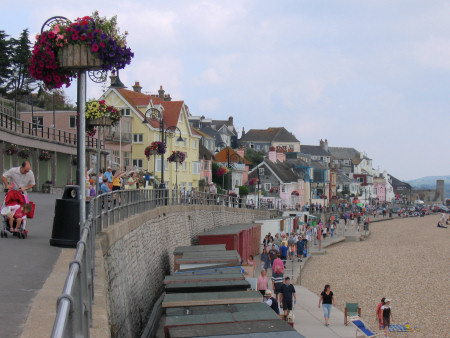
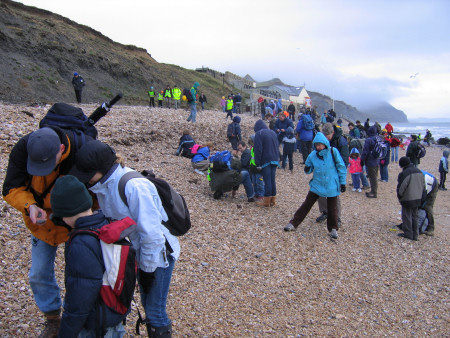
Left: View east
along the seafront towards the centre of Lyme Regis. Right:
Fossil hunters search the foreshore for loose fossils.
The best place to look for fossils is among the pebbles and rock pools on the foreshore, loose fossils including ammonites, belemnites and reptile bones can all be found with a little patience.
Fossils can also be found protruding through the surface of the slumping clays along the top of the beach. At high tide the waves wash away the soft clay, leaving the more resistant fossils exposed and able to be collected by hand.
A visit to Lyme Regis wouldn't be complete without viewing the ammonite graveyard, west of the town, at Monmouth Beach (see below). This incredible stretch of foreshore accommodates dozens, perhaps even hundreds of large ammonites among the boulders and in situ on exposed bedrock. These particular ammonites can't be collected, but their size and abundance makes them worth seeing all the same.
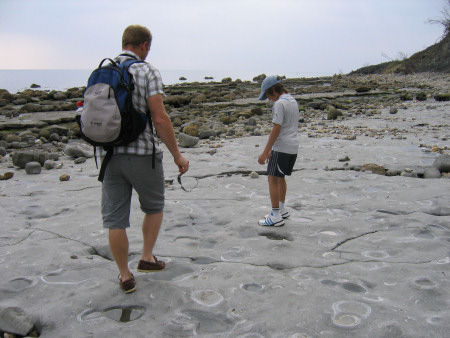
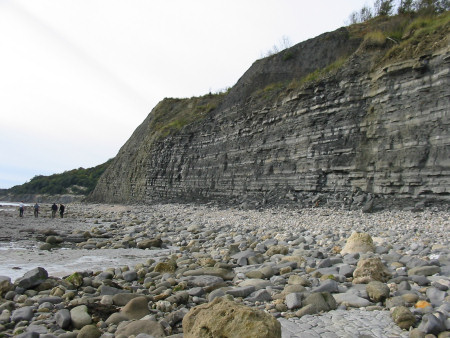
Left: Ammonite
graveyard on the foreshore at Monmouth Beach. Right:
View west at Monmouth Beach, beneath Ware Cliffs, towards Pinhay
Bay.
For visitors with little or no experience of the area, regular guided fossil walks take place and are highly recommended (see below). To hear about forthcoming Discovering Fossils trips please register here.
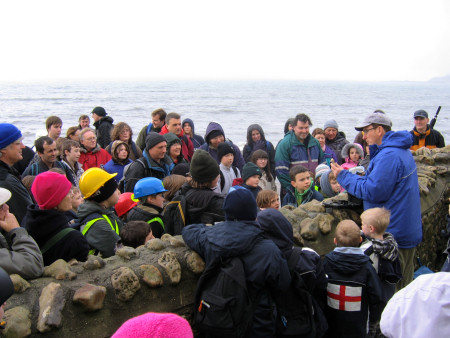

Left:
Local expert Chris Pamplin addresses participants on a Discovering
Fossils fossil hunt. Right: Slumping clays contain
a range of fossils on the surface.
As with all coastal locations, a fossil hunting trip is best timed to coincide with a falling or low-tide. For a relatively low one-off cost we recommend the use of Neptune Tides software, which provides future tidal information around the UK. To download a free trial click here. Alternatively a free short range forecast covering the next 7 days is available on the BBC website click here.
What fossils might you find?
The most commonly collected fossils are pyritised and calcified ammonites - with a little patience and a keen eye, most visitors will find at least one. To read more about ammonites click here. Other frequent finds include the bones of marine reptiles, in particular ichthyosaur vertebrae. The ichthyosaur specimen below, displayed in the Hamburg Zoological Museum, illustrates the position of the vertebra relative to the rest of the skeleton.

A complete skeleton of a juvenile
ichthyosaur displayed in the Hamburg Zoological Museum - for
illustrative purposes only.
Below are a selection of finds, made over several visits. If you find something of particular interest during your own visit, please seek advice and support at the neighbouring Charmouth Heritage Centre, or alternatively contact us on your return.
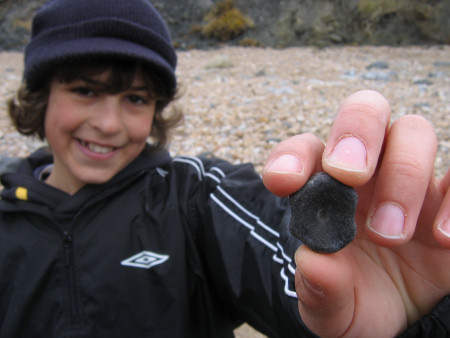
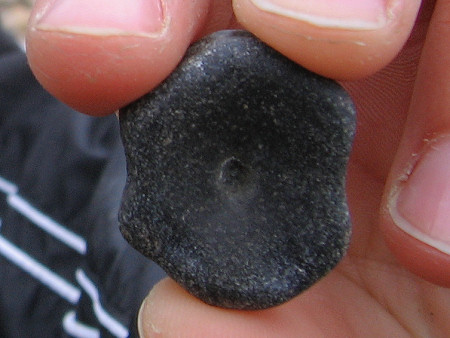
Left: Isaac holds his
prized find of the day - an ichthyosaur vertebra, from the foreshore
beneath Black Ven. Right: Close-up.
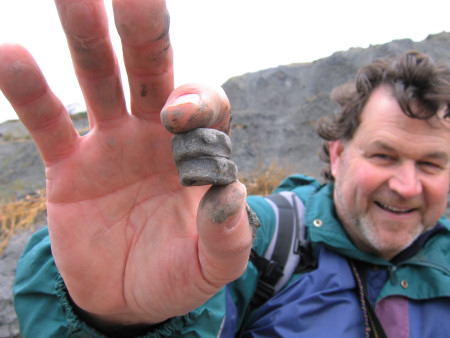
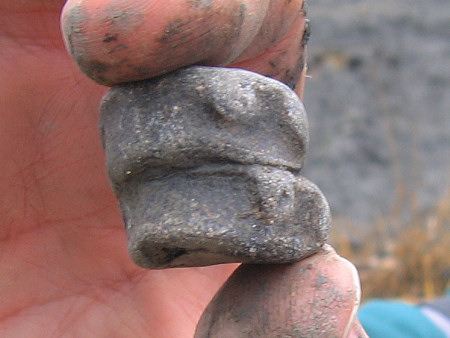
Left: A Discovering
Fossils participant holding two connected ichthyosaur vertebra, from
the slumping clays beneath Black Ven. Right: Close-up.
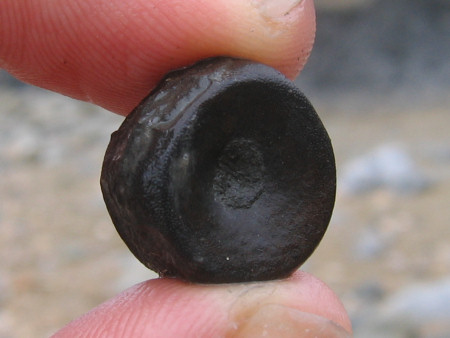
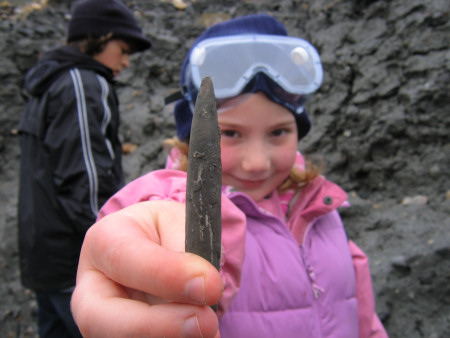
Left: A third
ichthyosaur vertebra, found within the slumping clays beneath Black Ven.
Right: A belemnite guard from the clays beneath Black
Ven.
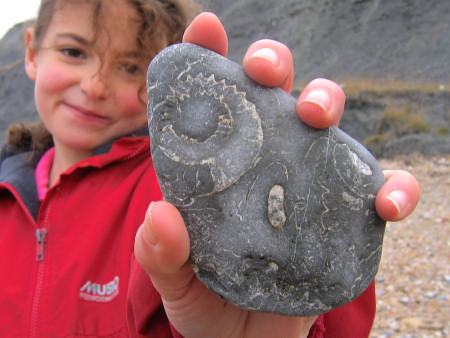

Left: A Discovering
Fossils participant holding a rolled foreshore pebble containing several
partial ammonite shells, found beneath Black Ven.
Right: A Discovering Fossils participant with a
pyritised ammonite (Eoderoceras) from the Stonebarrow Pyritic
Member.
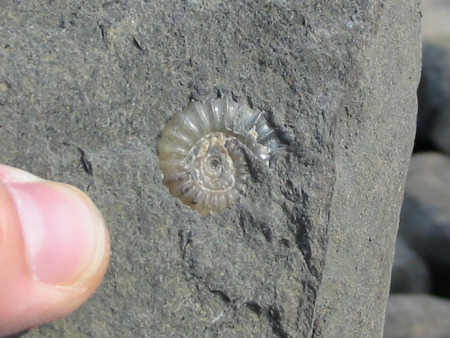
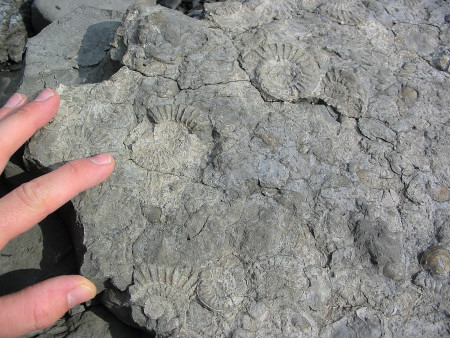
Left: A small, calcified
ammonite (Promicroceras) within a split pebble, found on the
foreshore beneath Church Cliffs, Blue Lias Formation.
Right: An ammonite graveyard exposed in situ on the
foreshore beneath Black Ven, Shales-with-Beef Member?.
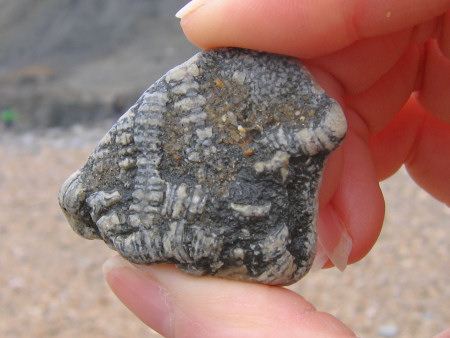
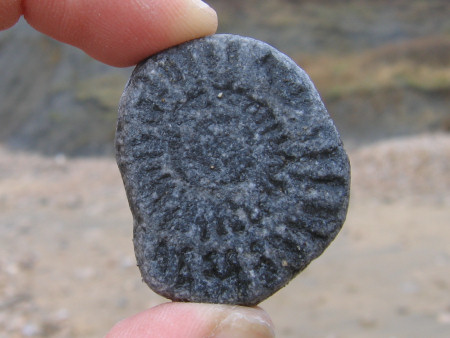
Left: A worn beach
pebble containing jumbled fragments of crinoid stems, found on the
foreshore beneath Black Ven.
Right: A crushed ammonite from the Shales-with-Beef
Member, found on the foreshore beneath Black Ven.
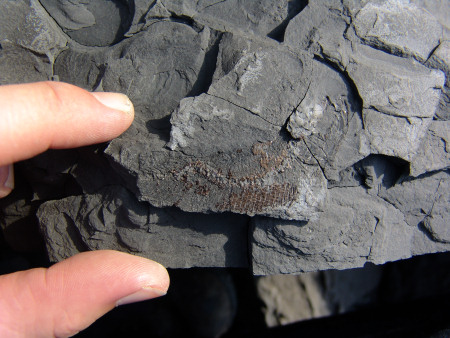
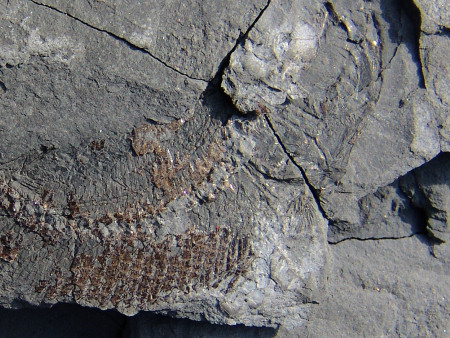
Left: A small fish
skeleton with scales (Pholidophorus?) found within fallen
shales originating from the Shales-with-Beef Member.
Right: Close-up showing the skull in the upper-right
and backbone with overlying scales travelling towards the lower-left.
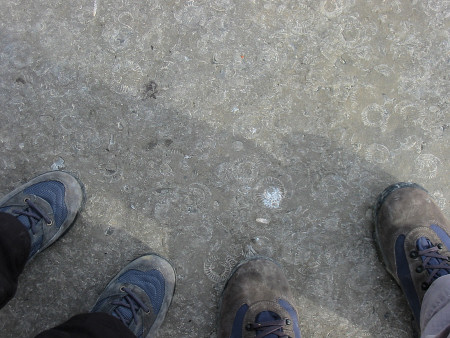
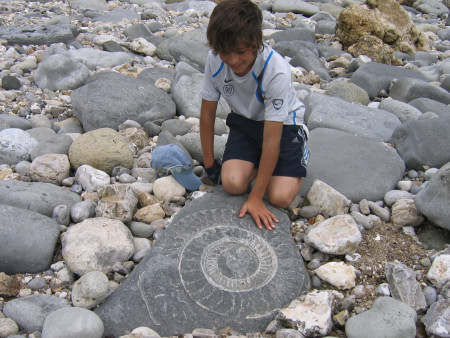
Left: Hundreds of
crushed ammonites in situ on foreshore at Monmouth beach, beneath Ware
Cliffs.
Right: Another large ammonite (Paracoroniceras?)
on the foreshore at Monmouth beach, beneath Ware Cliffs.
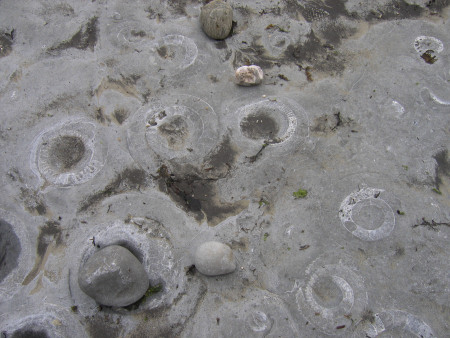
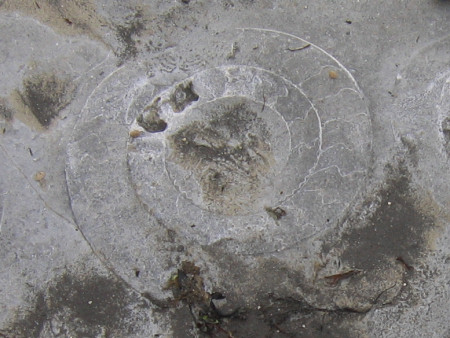
Left: A dozen or more
ammonites (Paracoroniceras?) pictured on the foreshore at
Monmouth beach, below Ware Cliffs. Right: A close-up.

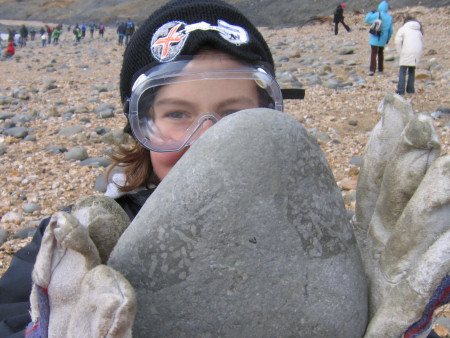
Left: A piece of
fossilised wood alongside several ammonite fragments. Right:
A rather heavy foreshore boulder containing worm
burrows.
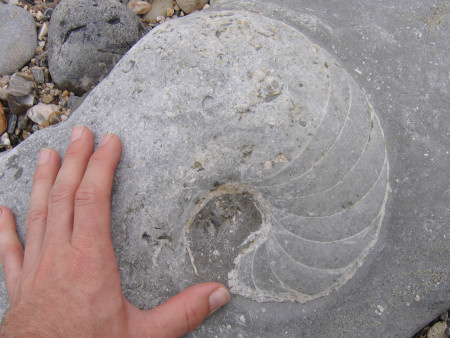
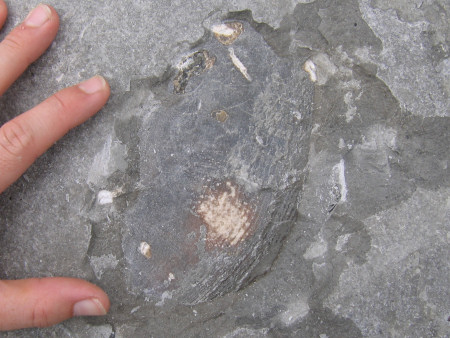
Left: A large
nautilus in cross-section on the surface of a foreshore boulder at
Monmouth Beach, beneath Ware Cliffs.
Right: A second nautilus shell partly exposed on a
foreshore boulder, also on the foreshore at Monmouth Beach.
Tools & equipment
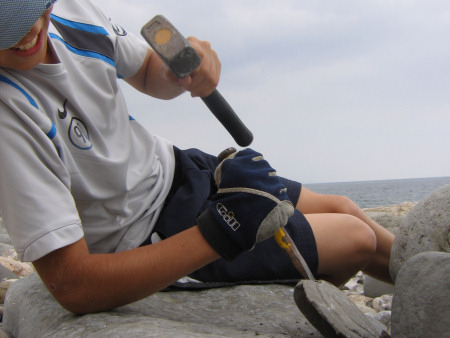
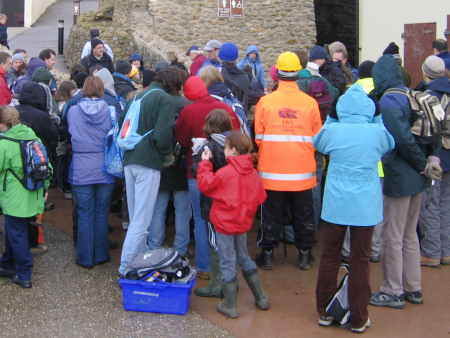
Left: A hammer &
chisel are recommended for splitting prospective rocks. Right:
A strong rucksack and footwear suitable for a rocky terrain are recommended.
It's a good idea to spend some time considering the tools and equipment you're likely to require while fossil hunting at Lyme Regis. Preparation in advance will help ensure your visit is productive and safe. Below are some of the items you should consider carrying with you. You can purchase a selection of geological tools and equipment online from UKGE.
Hammer: A strong hammer will be required to split prospective rocks. The hammer should be as heavy as can be easily managed without causing strain to the user. For individuals with less physical strength and children (in particular) we recommend a head weight no more than 500g.
Chisel: A chisel is required in conjunction with a hammer for removing fossils from the rocks. In most instances a large chisel should be used for completing the bulk of the work, while a smaller, more precise chisel should be used for finer work. A chisel founded from cold steel is recommended as this metal is especially engineered for hard materials.
Safety glasses: While hammering rocks there's a risk of injury from rock splinters unless the necessary eye protection is worn. Safety glasses ensure any splinters are deflected away from the eyes. Eye protection should also be worn by spectators as splinters can travel several metres from their origin.
Strong bag: When considering the type of bag to use it's worth setting aside one that will only be used for fossil hunting, rocks are usually dusty or muddy and will make a mess of anything they come in contact with. The bag will also need to carry a range of accessories which need to be easily accessible. Among the features recommended include: brightly coloured, a strong holder construction, back support, strong straps, plenty of easily accessible pockets and a rain cover.
Walking boots: A good pair of walking boots will protect you from ankle sprains, provide more grip on slippery surfaces and keep you dry in wet conditions. During your fossil hunt you're likely to encounter a variety of terrains so footwear needs to be designed for a range of conditions.
For more information and examples of tools and equipment recommended for fossil hunting click here or shop online at UKGE.


ADVERTISEMENT BY UKGE - OFFICIAL ADVERTISING PARTNER OF DISCOVERING
FOSSILS
Protecting your finds
It's important to spend some time considering the best way to protect your finds onsite, in transit, on display and in storage. Prior to your visit, consider the equipment and accessories you're likely to need, as these will differ depending on the type of rock, terrain and prevailing weather conditions.
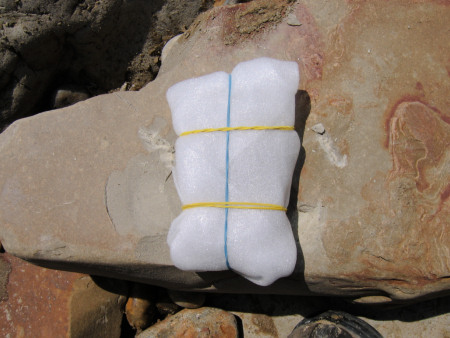
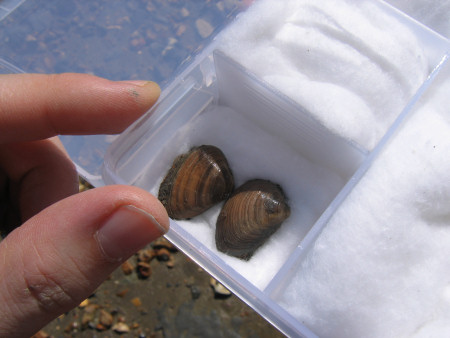
Left: Fossil
wrapped in foam, ready for transport. Right:
A small compartment box containing cotton wool is ideal for
separating delicate specimens.
When you discover a fossil, examine the surrounding matrix (rock) and consider how best to remove the specimen without breaking it; patience and consideration are key. The aim of extraction is to remove the specimen with some of the matrix attached, as this will provide added protection during transit and future handling; sometimes breaks are unavoidable, but with care you should be able to extract most specimens intact. In the event of breakage, carefully gather all the pieces together, as in most cases repairs can be made at a later time.
For more information about collecting fossils please refer to the following online guides: Fossil Hunting and Conserving Prehistoric Evidence.
Join us on a fossil hunt
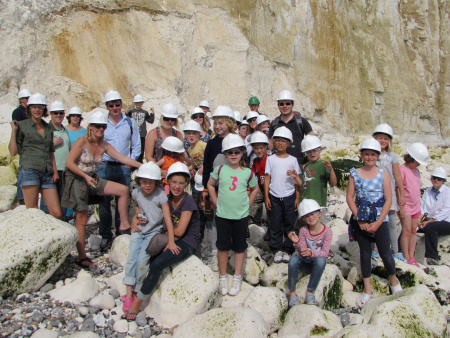
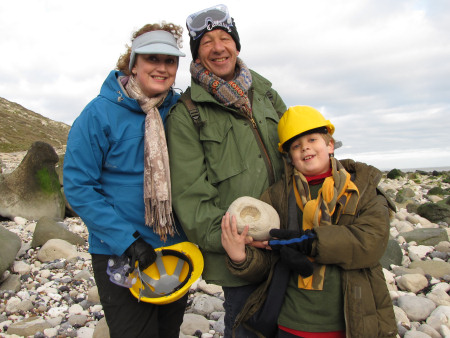
Left: A birthday party with
a twist - fossil hunting at
Peacehaven.
Right: A family hold their prized ammonite at Beachy Head.
Discovering Fossils guided fossil hunts reveal evidence of life that existed millions of years ago. Whether it's your first time fossil hunting or you're looking to expand your subject knowledge, our fossil hunts provide an enjoyable and educational experience for all. To find out more CLICK HERE

